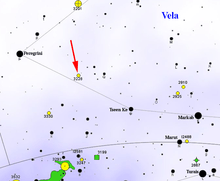NGC 3228
NGC 3228 is an open cluster in Vela. It was discovered by Nicolas Louis de Lacaille in 1751–1752, while he was in South Africa and catalogued it as Lac II.7.[3] It is small but bright and can be observed easily with binoculars in sufficiently dark skies.[4]
| NGC 3228 | |
|---|---|
 Location of NGC 3228 | |
| Observation data (J2000 epoch) | |
| Constellation | Vela |
| Right ascension | 10h 21m 22s[1] |
| Declination | −51° 43′ 42″[1] |
| Distance | 1,870 ly (573 pc[2]) |
| Apparent magnitude (V) | 6.0 [1] |
| Apparent dimensions (V) | 11'[2] |
| Physical characteristics | |
| Estimated age | 260 million years[2] |
| Other designations | Collinder 218, vdBH 93 |
It is a cluster of Trumpler type I1p or II3p, with few members with large brightness range and a slight concentration toward its center.[3] Klarchenko et al. mention 53 possible members within the angular diametre of the cluster. The tidal radius of the cluster is 1.4 – 5.5 parsecs (4.5 – 18 light years) and represents the average outer limit of NGC 3228, beyond which a star is unlikely to remain gravitationally bound to the cluster core.[2] The brightest member is of mag. 7.9 and the hottest star is of spectral type B9.[3] One member, HD 89856 (mag. 9.04, spectral type B9), is a variable star with period 4.556 days.[5]
References
- "NGC 3228". SIMBAD. Centre de données astronomiques de Strasbourg. Retrieved 2015-06-19.
- Kharchenko, N. V.; Piskunov, A. E.; Schilbach, E.; Röser, S.; Scholz, R.-D. (3 October 2013). "Global survey of star clusters in the Milky Way". Astronomy & Astrophysics. 558: A53. arXiv:1308.5822. Bibcode:2013A&A...558A..53K. doi:10.1051/0004-6361/201322302.
- Kronberg, Christine; Frommert, Hartmut. "NGC 3228". messier.seds.org.
- Monks, Neale (2010). Go-To Telescopes Under Suburban Skies. Springer Science & Business Media. p. 40. ISBN 9781441968517.
- Paunzen, E.; Hensberge, H.; Maitzen, H. M.; Netopil, M.; Trigilio, C.; Fossati, L.; Heiter, U.; Pranka, M. (26 November 2010). "A photometric long-term study of chemically peculiar stars in open clusters". Astronomy & Astrophysics. 525: A16. arXiv:1012.0149. Bibcode:2011A&A...525A..16P. doi:10.1051/0004-6361/200913789.
External links
- NGC 3228 on WikiSky: DSS2, SDSS, GALEX, IRAS, Hydrogen α, X-Ray, Astrophoto, Sky Map, Articles and images